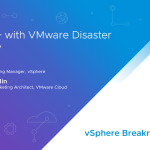VMware vSphere Data Protection (VDP) is a backup and recovery solution that was introduced with vSphere 5.1. VDP leverages proven technology from EMC Avamar to provide reliable, space-efficient, disk-based data protection for VMware virtual machines (VMs). VDP is fully integrated with VMware vCenter Server and the vSphere Web Client. One of the real beauties of VDP is its ease of deployment and management which explains why thousands of VMware customers have already downloaded VDP since it was introduced last year.
Simply put, VDP is backup and recovery for VMware, from VMware.
Last week at VMworld, VDP 5.5 was introduced which further extends the capabilities of VDP. Here are details on these new capabilities in VDP 5.5…
– Replication of backup data to EMC Avamar
Replication provides a more efficient, secure means to move backup data offsite for disaster recovery purposes (versus legacy tape solutions). Service providers will be able to offer services for receiving, storing, and archiving backup data replicated from VDP at a customer site to Avamar located in service provider data centers. If an organization has an existing Avamar implementation, this can also be used as a target for backup data replicated from VDP.
The replication engine is very robust, efficient, and flexible. It is possible to replicate backup data for all VMs backed up by the VDP appliance or select individual VMs. Since the backup data is de-duplicated at both the source and destination and only changed data segments are sent across the wire, bandwidth utilization is minimized – no need for WAN acceleration technologies. Replication schedules and retention policies can be customized and are separate from backup job schedules and retention. For example, VDP can have a backup job with a daily schedule and a 60-day retention and then replicate the backup data to a service provider weekly with a retention policy of one year at the service provider location. It is even possible to restrict which backup data is replicated, if desired. For example, the three most recent backups or backups that occurred within a specific time period (by date).
SunGard and Secure-24 are planning to offer a backup data replication target service for VDP and I expect many more service providers will offer this service in the near future.
– Direct-to-Host Emergency Restore
The restore of a virtual machine directly to a host can be accomplished without the need for vCenter Server and the vSphere Web Client. This capability is especially interesting for those who plan to use VDP to backup vCenter Server. This was a popular feature request and we are now happy to deliver with VDP 5.5!
– Backup and restore of individual .vmdk files
Speaking of feature requests, this was the most requested: The option to select individual .vmdk files when creating/editing a backup job or performing a restore. Granted, this capability should have been in the initial release of VDP – all I can say is better late than never. 🙂
– Granular scheduling for backup and replication jobs
Specific times can be selected to start backup and replication jobs. For example, Backup Job 1 is scheduled to start at 9:05 PM, Backup Job 2 is scheduled to start at 10:20 PM, and Replication Job 1 is scheduled to start at 1:30 AM. Of course, backup jobs should still be scheduled during the backup window.
– Flexible VDP storage management
When deploying VDP, separate data stores can be selected for the VDP guest OS and backup data partitions. It is also possible to mount an existing VDP backup data partition to a new VDP appliance during deployment. As an example, this is useful if by chance the .vmdk file containing the VDP guest OS is corrupted or lost. A new VDP appliance could be deployed and the existing backup data partition added to the new appliance thus preserving that existing backup data.
As many of you already know, there are two flavors of vSphere Data Protection (VDP) There is VDP, which is included with vSphere Essentials Plus and higher, and there is VDP Advanced, which is more robust and sold separately.
VDP Advanced 5.1 provides an agents for SQL Server and Exchange (unlike VDP) that are installed in the guest operating system of a VM running either of these applications. The agents enable more granular backup and restore capabilities. For example, you can select individual databases for backup or restore. The agent also provides application quiescing, client-side de-duplication, and more advanced backup options such as log truncation, full or incremental backups, and the ability utilize multiple backup streams.
VDP Advanced 5.1 also allows dynamic capacity growth (unlike VDP). For example, you can start with a VDP Advanced appliance that is configured with 2TB of de-duplicated backup data capacity and grow that capacity to 4TB, 6TB or 8TB as needed. VDP (not Advanced) is limited to 2TB. It is possible to migrate from VDP to VDP Advanced and preserve existing VDP backup data.
Understanding the latest versions of vSphere Data Protection (VDP) are VDP 5.5 and VDP Advanced 5.1, that begs the question “Are the new features in VDP 5.5 described above also in VDP Advanced 5.1?” Short answer: No, these new VDP 5.5 features are not in VDP Advanced 5.1. As most of you know, we cannot discuss specific road map information in forums such as this. However, we can take a brief look at the history of VDP releases and theorize a bit: VDP 5.1 (not Advanced) was initially announced with vSphere 5.1 at VMworld in 2012. Early this year, VMware introduced VDP Advanced 5.1 with all of the features of VDP 5.1 – and more! At VMworld last week, VMware introduced VDP 5.5 and its new features with vSphere 5.5. I’ll let you take it from there… 🙂
By the way, I did not include any screen shots. I have something better – check out this site if you want to “walk through” some of the new features of VDP 5.5, as well as, many other features and products that are available in VMware vCloud Suite 5.5:
http://vmwarewalkthroughs.com/vCloudSuite5-5/
@jhuntervmware
















